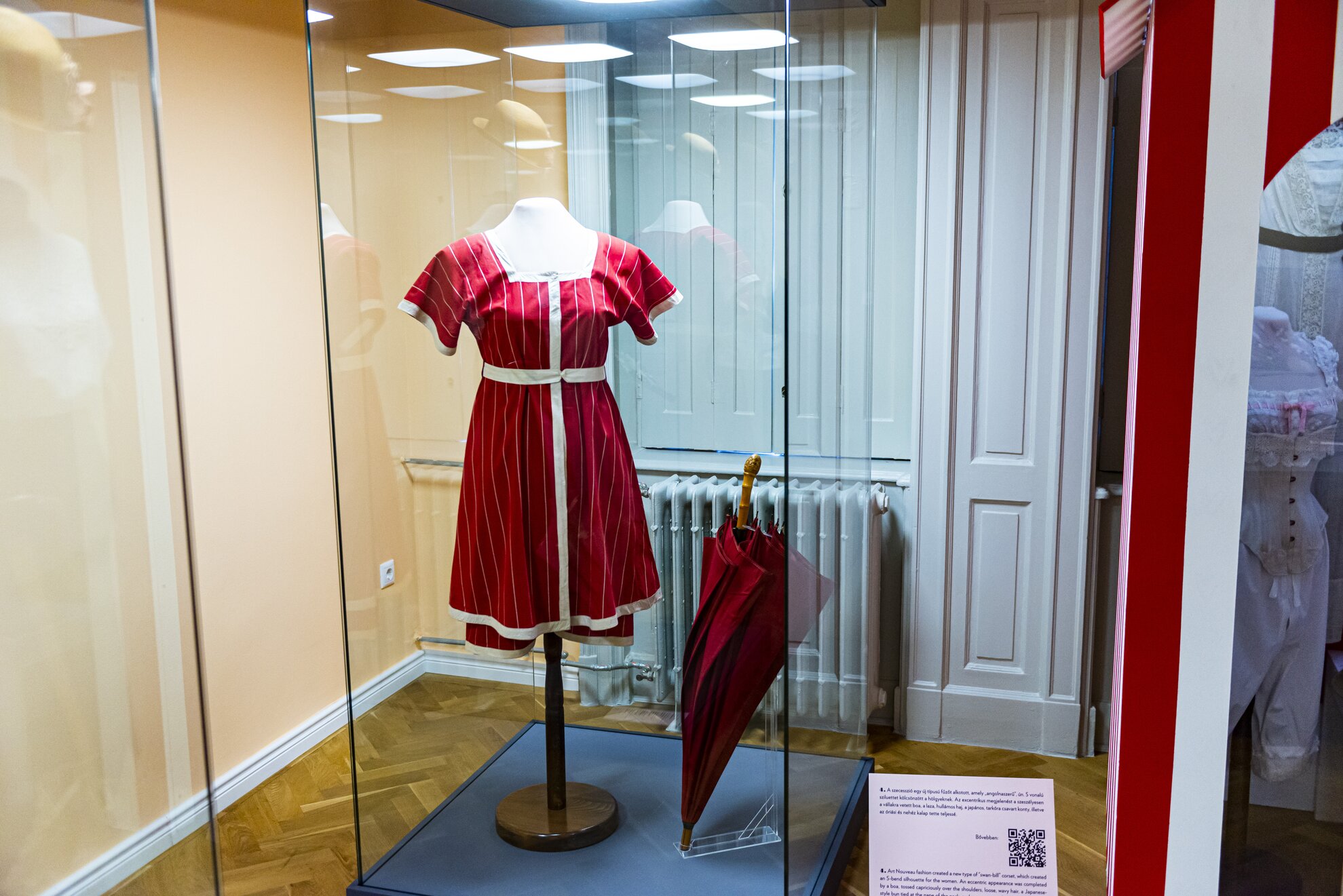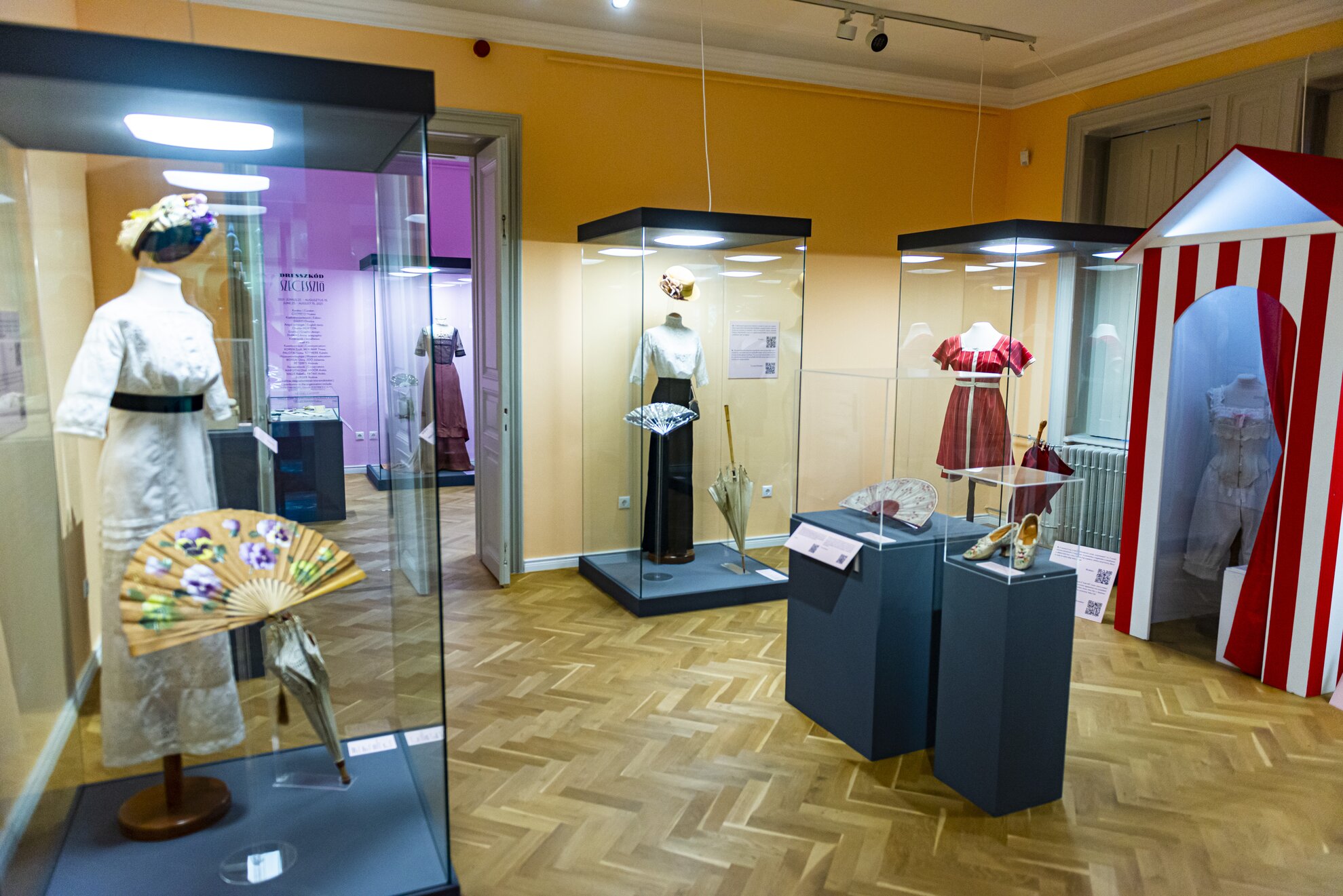What you see in a Dress Code: Art Nouveau is just a fraction of the 25,000-strong collection at the Museum of Applied Arts in terms of fashion history. It is never easy to exhibit these kinds of objects. Due to the washing and starching procedures of the time, the silk used in costumes often starts to break away, and even modern restoration techniques cannot save them. Now is the time to admire these fleeting and delicious artefacts.

The exhibition only seems small if you consider
that it begins from the front door. But a walk by the villa façades of
Városligeti fasor, imagining the huge, old chestnut trees that were would have
been magnificent around the turn of the century, already prepares the scene.
Back
then, this was a popular carriage ride and promenade, where ladies could
present their latest dresses, in hats that cast a mysterious shadow over their
delicate faces. You then approach the villa, bought and remodelled in 1901
by the first director of the Museum of Applied Arts, György Ráth. First admiring the
Art Nouveau objects of the permanent exhibition, you enter the interior.

Ladies that do Budapest
The ladies of the Art Nouveau era spent their days almost constantly dressing. After a short breakfast, they wore clothes for the home. Then they might go to the expensive downtown boutiques, around Petőfi Sándor and Váci utca, for their fashion items. The really affluent went to the Girardi Szalon, Monaszterly or Kuzmik, while the modest middle class visited Holzer on Kossuth Lajos utca. Shop windows displaying beautiful lingerie, hats and shoes outdid each other across the city centre. Outfits would have been shown off on the terrace of the Gerbeaud, at the racecourse or around Margaret Island. Since the afternoon requires a lot of walking, accessories were essential, from gloves to hat pins. They might also dedicate the afternoon to sport, but not so much that they gained any unseemly muscles. The evening was for theatrical and social events – all in different outfits, of course.
Emancipation of women

The exhibition space comprises two halls. The turn of the century was an interesting crossover period, as ladies were allowed to study in higher education from 1896 and play sport, but only in such a way that they remained attractive, as the main goal of these activities was to socialise and catch the most able suitor. And this was only possible if they stretched for the tennis ball with a delicate movement, perhaps with a cute giggle, and certainly not breaking sweat.

Expectations of ladies, it seems, have always
changed faster than the female ideal. How women looked represented the rank and
wealth of their families, and strict dress codes also defined their daily
lives. In the old days, only working women were tanned, so the ladies belonging
to any gentleman protected themselves against the heat and sun by all possible
means: wide hats, gloves, parasols and fans.
Over the age of 40, only ladies of pure virtue
could appear in purple, grey or black attire. It was at this time that news of
the unhealthiness of the corset began to spread, with a result that the
eel-shaped S-line silhouette now defined fashion.

The exhibition arranges the costumes based on
the most important locations related to the ladies’ lives. One of the most
exciting was the summer baths, where the younger generation of the same social
class could mingle with each other relatively easily.
After the day wear in
the first room, refined swimsuits immediately appear. A dark-coloured artefact,
decorated with white birds, for example, was unusually mischievous, as it had no sleeves
either.
Next to it, in the beach cabin for dressing, on a hanger, you can see a
dress beautifully decorated with lace which, despite being thoroughly cleaned,
is slightly stained, but it does not detract from the values of its wonderful
composition.

One of the most important elements of fashion, handkerchiefs and underwear, is lace. In addition to pieces by Hungarian workshops such as the Körmöcbánya Lace School and the Csetnek manufactory, you can see Halas lace sewn according to the designs of art teacher Árpád Dékány in a small display case.
In the main hall, on display are a practical, separately washable lace blouse and a simple black skirt, the hips threaded at 70cm for safety, for the working woman. Next to it, a snow-white, light-coloured dress with a huge fan and hat, echoes the era of the summer afternoon promenade.

The second room is given over to evening wear. After the headdress and elbow-length gloves worn for balls, a couple of superb examples of high fashion reflect the age and wealth of the wearer. It should be borne in mind that was not elegant to discuss the price of each item during the purchasing process. During ball season, the ladies took part in six or seven events, a new dress required for each.

Fashion icon
József Girardi, who created the rather heavy purple dress here (unlike the soft, light material also on display), bought a complete apartment house on downtown Apponyi tér – today’s Ferenciek tere – with the proceeds from the 163 women’s clothes he designed for the coronation of Károly IV, including Queen Zita's dress.

The other evening wear on display here is
Mariano Fortuny’s Delphos dress, inspired by Classical art, the rich
pleats and refined tailoring seeking to highlight the beauty of the female body
in a very modern way, without corsets.
A 1910s version of the one originally
worn as a indoors dress by one of the most beautiful women of the era, Klára
Zichy, can be seen here. The lady’s blue eyes and bright red hair became the
inspiration for works of art, and she grew into a true fashion icon alongside
her dull husband. Her photo and a kimono can be found in the permanent
exhibition.
The exhibition is open until 15 August.

Dress Code: Art Nouveau
Museum of Applied Arts
György Ráth Villa
District VI.
Városligeti fasor 12




